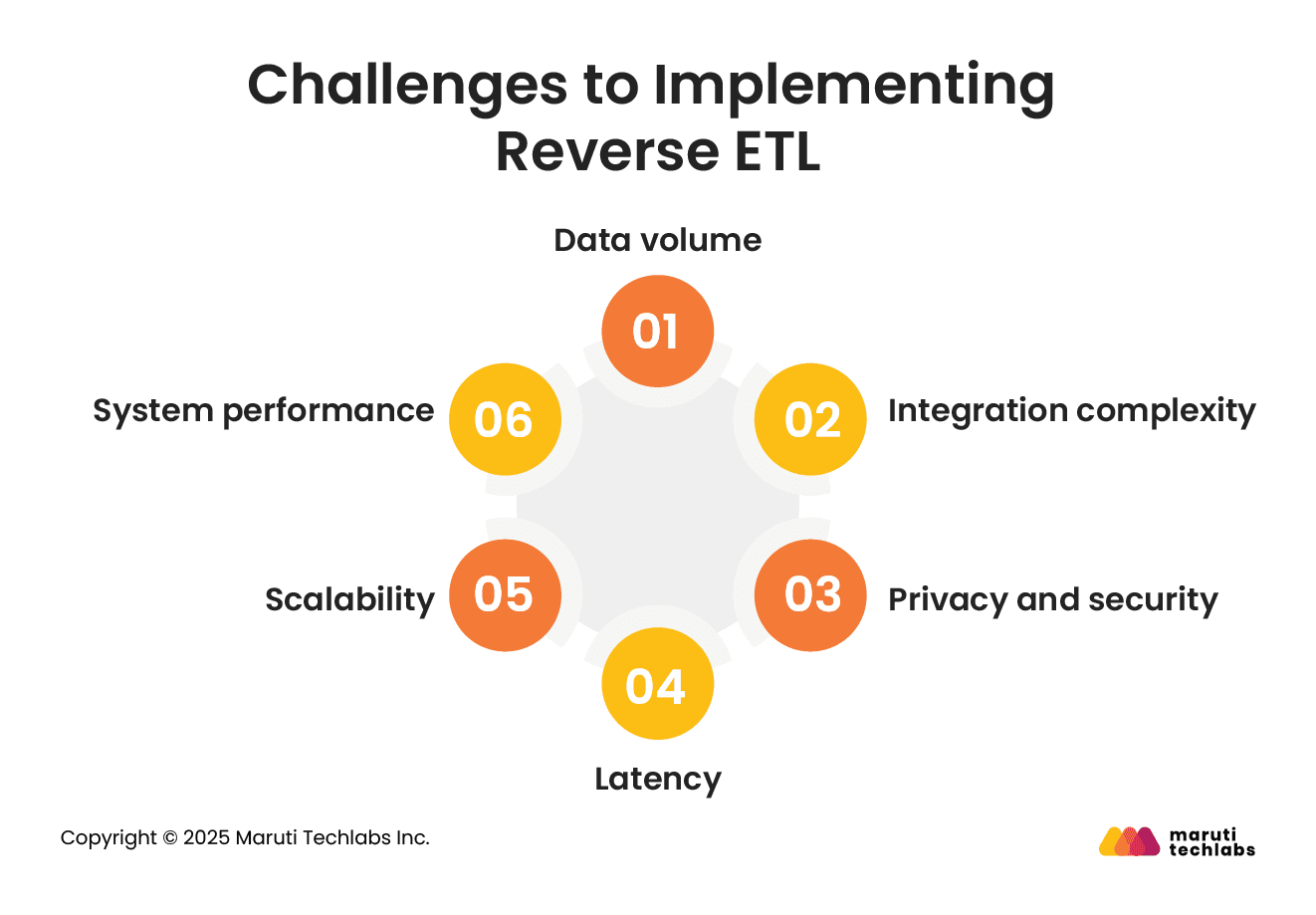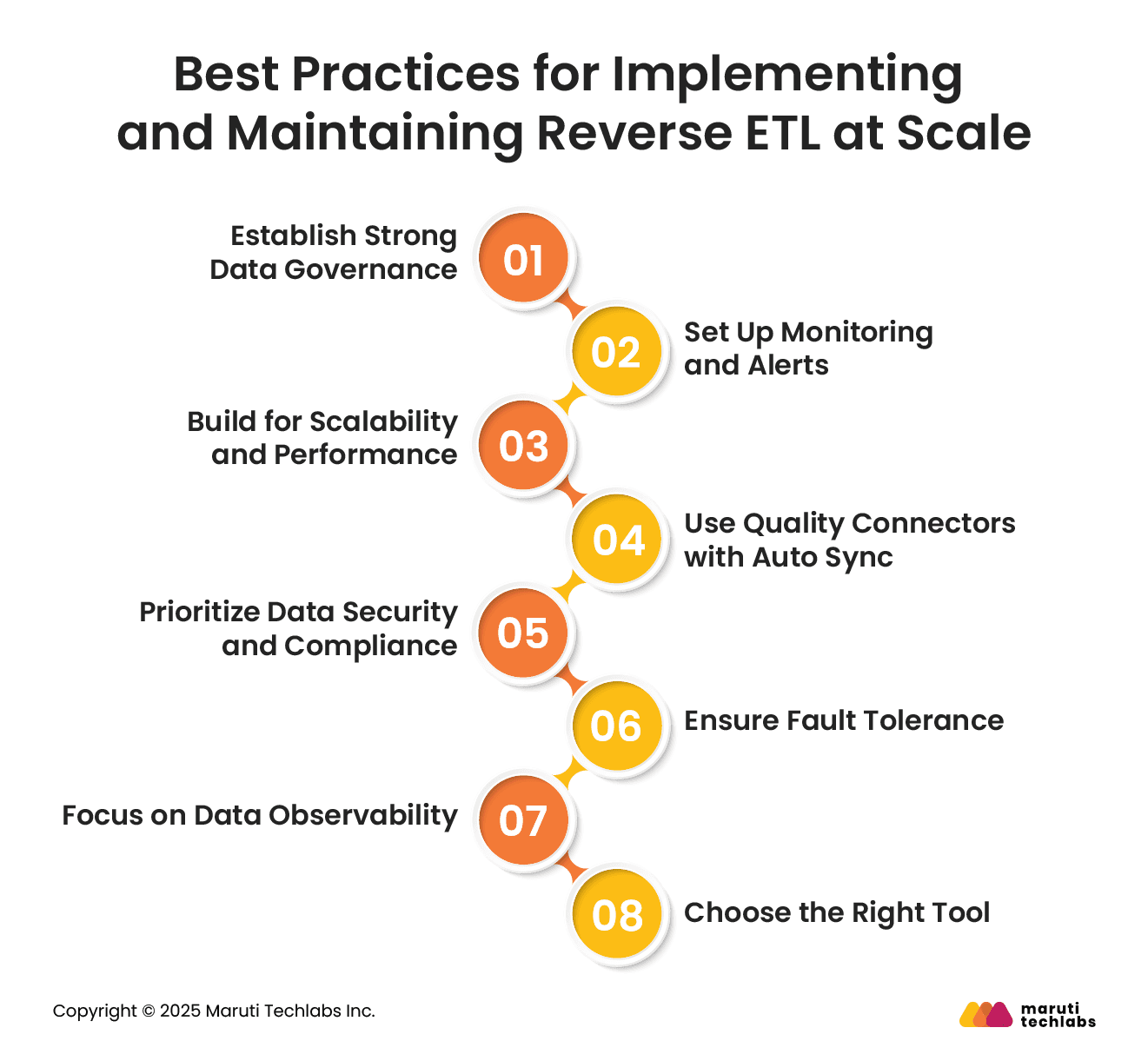

How Are Leading U.S. Companies Getting Reverse ETL Right?






Reverse ETL (Extract, Transform, Load) is a process that sends data from your warehouse into the tools your teams use every day, like CRMs, marketing platforms, or support systems. It’s the last step in the modern data stack that helps turn insights into action. Instead of just analyzing data, teams can use it where they work most.
In the U.S., more companies are turning to Reverse ETL to solve a common problem: data is often trapped in dashboards or accessible only to analysts. With Reverse ETL, that data gets pushed into everyday tools like CRMs and support platforms, so teams can use it to make decisions, take action faster, and stay aligned. It breaks down data silos, reduces back-and-forth between departments, and helps everyone work with the same accurate information.
Reverse ETL improves decision-making, personalizes customer experiences, and automates routine tasks by pushing clean, simplified data into operational tools. In this blog, we’ll explore the real-world challenges, best practices, popular tools, and lessons learned from large-scale Reverse ETL projects across the USA.
While Reverse ETL offers considerable value, it also has its share of challenges, especially when working with large data volumes and multiple business tools.

The sheer amount of data generated today is massive. Syncing all that data from your warehouse to various tools can become costly and difficult to manage. Many Reverse ETL tools charge based on data volume, so regular syncs with large datasets can quickly add up.
Not all data is created equal. Different tools store data in different formats, and matching it all up can be tricky. You’ll need to ensure your data is clean, consistent, and compatible with your destination systems and that your Reverse ETL tool supports the tools in your stack.
Whenever you move sensitive data like customer information or employee records, you open up potential security risks. Encryption, data masking, and strict access controls are essential to comply with laws like GDPR, HIPAA, or CCPA.
Real-time or near-real-time updates are often needed, especially when the data affects customer-facing teams. Any delay in syncing can lead to outdated decisions or inconsistent user experiences. Techniques like change data capture (CDC) can help reduce sync lag.
As your business grows, your data and tools grow with it. Your Reverse ETL setup must scale to handle more data, more frequent syncs, and more destinations. This requires not just the right tool, but smart data modeling and sync strategies.
Pushing large amounts of data into operational tools can strain their performance. It’s essential to monitor and manage how much data you’re sending to avoid slowing down the systems your teams rely on daily.
To make the most out of reverse ETL, it’s important to follow best practices that keep your data pipelines efficient, secure, and ready for growth. Here’s what to focus on:

Set clear rules for how data should be handled. This ensures consistency, accuracy, and compliance. With strong governance, business teams can trust the data they use, and regulators can too.
Things can go wrong in data pipelines. That’s why it’s essential to track your system using alerts, logs, and dashboards. Monitoring tools help spot problems early, before they disrupt your operations.
As your business grows, so does your data. Choose reverse ETL tools that scale smoothly and don’t slow down your systems. Whether handling real-time updates or processing large batches, your pipeline should run fast and stay reliable.
Most companies use dozens of SaaS tools, so reliable data connectors are critical. Make sure your reverse ETL tool easily connects to platforms like Salesforce, HubSpot, and Marketo. Automated syncing keeps data fresh without manual effort, giving business teams real-time insights to act on.
Reverse ETL tools move sensitive data, so security must be paramount. Choose tools that follow strict protocols like GDPR, HIPAA, and SOC 2. Encryption, access controls, and regular audits help protect data at every step.
Data loss can be costly. Use tools that detect failures early and recover quickly. Features like heartbeat checks and system rollbacks help keep your pipelines running, even during outages.
Observability means tracking the health of your data. It includes checking for freshness, format, volume, and schema changes. Tools with strong observability let you trace issues, audit changes, and trust your data.
Finally, select a reverse ETL tool that fits your tech stack, offers the right connectors, supports automation, and scales with your needs. The right tool doesn’t just move data; it empowers your teams to use it effectively.
Reverse ETL has become essential for operationalizing data from warehouses into everyday business tools. Several platforms now offer powerful capabilities to help businesses push insights to CRMs, marketing systems, and more.
Here’s a look at some of the top tools making reverse ETL faster, simpler, and more reliable:
Tool | Key Features |
| 140+ SaaS destinations, Git version control, granular permissions, and strong data governance. | |
| 85+ integrations, SQL model builder, visual data mapper, and works on your warehouse. | |
| Code-free pipelines, universal connectors, batch loading, and intuitive dashboards. | |
| 300+ prebuilt connectors, schema drift handling, automated governance and updates. | |
| 130+ sources, 900+ components, orchestration and monitoring features. | |
| 300+ no-code connectors, open-source flexibility, stream-level data freshness. | |
| Focused on CRM/finance tools, new integrations released often, and simple setup. | |
| Seamless syncing, scalable infrastructure, easy data transformation, and activation. |
Two well-known U.S.-based companies, CrossFit and MongoDB, have seen impressive results using Reverse ETL.
CrossFit wanted to connect more meaningfully with people across its three business areas: Gym Affiliates, Sport, and Education. Many assumed CrossFit was only for hardcore fitness enthusiasts. But by using Twilio Segment, the team created unified customer profiles from different systems and delivered personalized messages. This helped explain the full value of their programs and brought more casual users into the fold.
As a result, CrossFit saw a 24% increase in registration click rates for its global competition, the CrossFit Open, and saved 10–15 hours per campaign by automating email outreach. Most importantly, it grew its community through more targeted and effective communication.
A popular database company, MongoDB, used Reverse ETL to share helpful product info with developers at just the right moment. When someone appeared stuck while using their platform, MongoDB sent helpful content through live chat, email, or pop-ups—whichever worked best for that user. This timely approach led to a 100x increase in event registration rates and improved ad performance.
Both examples show how Reverse ETL can turn raw data into personalized, real-time action that builds stronger connections and drives results.
Reverse ETL helps teams move faster by turning static data into real-time insights that drive real business results. But for it to work well, it needs careful planning and ongoing checks to keep things on track. Without a clear strategy, it’s easy to lose track of data quality, sync frequency, or how well teams are actually using the data.
Companies that bring in the right talent, especially experienced data engineers, can shift from slow, outdated processes to being agile and data-driven. These organizations are better equipped to respond to customer needs, spot trends early, and drive more meaningful growth.
Whether you're just getting started or want to scale your data operations, having the right partner makes all the difference. Connect with Maruti Techlabs for scalable, insight-driven Data Engineering Services that help you move data where it matters, when it matters.
Reverse ETL helps you move data from your data warehouse into tools your teams use daily, like CRMs, ad platforms, or support systems. It makes insights more actionable by syncing cleaned, processed data directly into those tools.
You can use reverse ETL for personalization, lead scoring, customer segmentation, and more—all without manual data entry or switching between dashboards and spreadsheets.
To improve ETL performance, start by optimizing how and when your jobs run—avoid peak hours, and batch where possible. Use incremental rather than full loads, and make sure your queries are efficient.
ETL can face issues like slow data loads, high latency, or failed jobs. These often happen due to complex transformations, inefficient queries, network issues, or trying to process too much data at once. As your data grows, these problems can get worse without proper scaling.
Poor scheduling and lack of monitoring also make it hard to fix issues quickly, leading to delays and unreliable data.
A Customer Data Platform (CDP) collects and unifies customer data from various sources to build profiles and support marketing efforts. It’s an out-of-the-box system primarily designed for marketers.
Reverse ETL, on the other hand, takes data from your warehouse and sends it to tools like Salesforce or HubSpot. Think of it as a pipe that delivers your cleaned data where needed.


